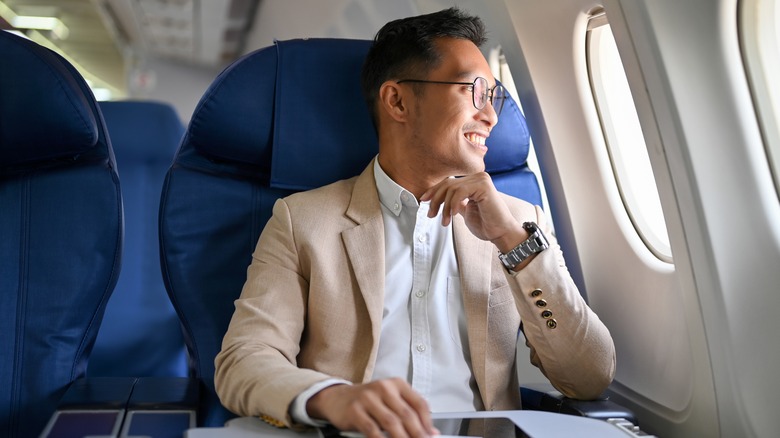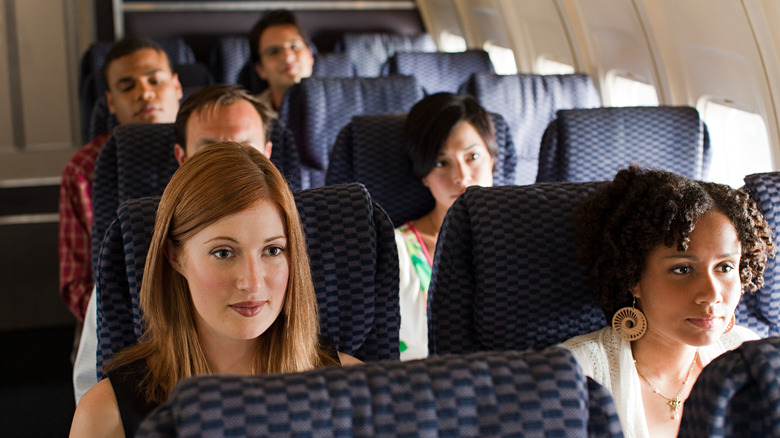This Plane Seating Arrangement Is Technically Safer But Passengers Hate It
Flight safety is crucial no matter which airline you fly with or how much you paid for your ticket, though some seats are safer than others. According to a 2015 Time investigation, the safest airplane seats are the middle seats in the back of the plane — yep, the last area to disembark and close to the stinky lavatory.
However, any seat could be made a little safer with one simple tweak: Turn it backward. According to aviation safety experts, rear-facing seats on planes are safer than the traditional forward-facing ones. Data on the subject goes back to at least 1952, when an article published in "Naval Aviation News" stated, "Passengers in Navy transport planes have ten-fold better chances of coming out of crashes alive, thanks to backward-facing seats which are being installed in all new planes" (via Smithsonian Magazine). Many military aircraft still have aft-facing seats today, though the trend never seemed to catch on in commercial planes.
In 2022, an unnamed representative from SAE International, a company that develops safety standards, also confirmed the benefits of backward seats to Reader's Digest: "Forward-facing seats allow the occupant's upper torso to move forward and consequently do not provide the same level of protection [as rear-facing seats]." If seats are rotated, they offer more support to the upper body during an impact or crash.
Why do most plane seats face forward?
If seats would be safer facing the tail of the plane, why do they almost always face the front? One factor comes down to passenger preference. Most people — or, rather, most adults — like to face the same direction as the vehicle they're in. This was revealed in a 1985 study published in the American Journal of Public Health, where seating preferences were recorded in metro trains containing multi-facing seats. While 66% of children chose to face backward in the train carriages, only 25% of adults did the same.
Altering the standard seating arrangement could also cost airlines a lot of money. Besides needing to rip out and rotate seats, companies would have to redesign entire cabins and budget for additional costs. David Learmount, operations and safety editor at FlightGlobal.com and a former RAF pilot and flight instructor, shared with The Telegraph, "During an impact, the passenger's [center] of gravity would be higher and the seat would be taking more of the strain – therefore the seat itself, the fittings, and the floor of the aircraft would need to be strengthened. That would increase the weight of the aircraft, which would increase fuel consumption." Given the hassle and higher operating costs, don't expect to see any major changes to flight seats any time soon.
Some airlines embrace rear-facing seats
If you're concerned about staying safe while traveling, or if you simply share the playfulness of the train-study children, you might be able to nab a rear-facing seat if you know where to look. In 2023, TikTok creator Megan Homme shared a viral video of her flight's unique layout, where rows faced each other, allowing for both front-facing and rear-facing seats (and given the knee-to-knee configuration, she didn't seem so thrilled about the design). Though Homme didn't name the carrier, she noted in a comment that it was a regional airline in Sweden.
Across the pond, British Airways also uses some rear-facing seats in the middle blocks and near the windows in its upgraded Club World cabins. United Arab Emirates-based Etihad Airways also utilizes backward seats in a few of its aircraft, but like British Airways, they're only found in upgraded airline classes.
In the U.S., rear-facing seats are becoming increasingly rare. Southwest Airlines once included aft-facing seats in its lounge configurations but began phasing them out in the 1990s. Today, you can still find backward seats in some United and American Airlines business class layouts.

